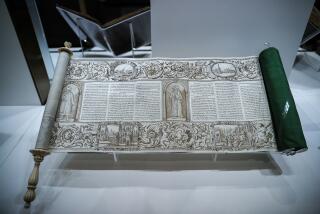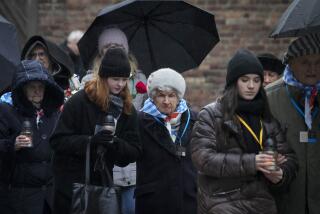HOLOCAUST JOURNEY Traveling in Search of the Past By Martin Gilbert, Columbia University Press: 468 pp., $27.95
Halfway through Martin Gilbert’s journal recording his recent travels to the death camps of the Holocaust, he excerpts a chilling portion of Salmen Gradowski’s diary. Gradowski was a Jew assigned to cleaning and maintaining the crematories at Auschwitz. He wrote: “Great quantities of teeth are also buried [on the grounds of the camp]. It was we, the Kommando workers, who expressly have strewn them all over the terrain, as many as we could, so that the world should find material traces of the millions of murdered people.”
Gilbert’s reckoning with these horrifying traces and haunted places has resulted in a book that is both shocking and strangely numbing. Such reactions are not uncommon when dealing with genocide, but they also underscore the limitations as well as the strengths of his “Holocaust Journey.”
“Holocaust Journey” is a detailed record of the two-week trip Gilbert made with a group of his graduate students and survivors to the sites of the Holocaust; he also includes the histories, diaries and letters they read in each place. At the end, Gilbert summarizes what this pilgrimage accomplished. It gave “insight into some of those horrors,” it provided information about the Nazis and others who perpetrated the killings, it taught about “the sufferings and courageous acts of the victims” and it set all of this devastation against the rich background of Jewish history. This encounter with place, source and memory made everyone experience “the pain that can be felt in exploring the past.”
The Holocaust that emerges in these extraordinarily well-researched pages is overwhelmingly one of horror and suffering. You cannot read this book without recognizing the destruction brought by the Holocaust, town by town, city by city, family by family.
Gilbert provides a wealth of information on the vanished world of murdered Jewry. After passing through one town after another whose once-thriving Jewish quarter has been reduced to a plaque, a monument and a synagogue turned into a museum, the abstract millions of deaths are changed into vivid images of emptied communities. For all the power of Gilbert’s devoted scholarship, though, “Holocaust Journey” is nearly impossible to read through. Gilbert’s uniform vision of the camps and their consequences muffles individual voices and actually keeps those terrible events at a distance. It may seem cowardly, even immoral, to suggest that a relentless accounting of the evil of the camps is somehow misguided. But the real question is whether such an endless repetition of horror and death is the best way to bring us closer to those agonizing events.
At key moments in the book, Gilbert wrestles with the problem that massive evil presents for anyone who studies or reads about it: “How does one cope with such an enormous death toll? In our mind’s eye, when we focus on individuals, we can begin to grasp the scale, but it is so vast the mind is numbed.” That numbness is something that everyone who comes close to the Holocaust is sure to feel; we put it on as a suit of armor when we pick up a book, enter an exhibit or watch a film. But what comes next? What happens when we move past that emotional guard? Gilbert gives one clue: the events “as set down by eyewitnesses in letters and diaries, or by survivors in their memoirs, come close to defying the most vivid imagination. If one really could ‘imagine’ what one reads and studies, would one not go mad?”
“Holocaust Journey” is an effort to negotiate between the two dangers of falling numb in the face of suffering that no words can describe and being consumed with grief, despair or even madness in the face of such pain. It does not succeed. By recounting even the most minor details of each minute and hour, Gilbert retreats behind date, schedule and fact. At the same time, he inundates us with gruesome stories of horrible death. As a result, we are simultaneously removed from and overwhelmed by the history he retraces and recounts. In this book, his answer to the problem of describing the indescribable is, in words the novelist Francine Prose used to explore this exact problem in fiction, “a guided tour of hell.”
In part, the limitation of “Holocaust Journey” is a result of its origin. If you propose to publish a journal of a journey, a few entries will inevitably sound as dull as “4:20 p.m. Vineyards” or “11:35 a.m. We drive down Karl-Marx-Allee.” Some of the annoying and all-too-frequent repetitions of bits of information, each presented as if for the first time, are probably unavoidable in a book whose structure depends on what Gilbert actually said at a given time and place. In a work whose pages are filled with the most extreme accounts of cruelty and evil, however, such residues of the original diary are especially discordant. They ensure that instead of entering the Holocaust through the journey, we remain outside of both.
For the most part, though, it is Gilbert’s approach to the Holocaust that defeats his own purpose. As the group leaves one of the best-known camps, Gilbert writes: “After three hours walking around Theresienstadt, looking at so many buildings and talking about what happened in each of them, one has a strange sense of the multitude who once suffered there. I had originally thought of writing ‘lived’ there, but it hardly seems appropriate.” In this book, a Jew is not an individual who lives and dies, he is a representative of a suffering mass. We see this clearly in an account of the camps that Gilbert says “brings us as close as we will ever get, having not experienced it, to the reality of what happened here. To the reality of the Holocaust.”
*
That account comes from the report left by Jan Karski, a member of the Polish underground who traveled to a death camp in Poland to see what was taking place. At great risk, Karski brought word of the hell he had seen to Britain and America. Karski’s record is filled with excruciatingly graphic scenes. “[T]he Jewish mass vibrated, trembled, and moved to and fro as if united in a single, insane, rhythmic trance,” he wrote. “They waved their hands, shouted, quarreled, cursed, and spat at each other. Hunger, thirst, fear, and exhaustion had driven then all insane.”
The closest we can get to the reality of the Holocaust, then, is to picture what Karski calls “a quivering cargo of flesh.” There is a kind of grim respect in defining the Holocaust this way, as if in the face of so much undeserved agony, we have no right to do anything but mourn. Yet homogenizing all of the unique voices of Holocaust literature into a litany of horror prevents us from entering into any one person’s story with our hearts. When we read the actual documents of the Holocaust, what we see is not just death but life.
Gilbert gives some sense of this variety when he tells us about the heroism and courage of Jews such as Nahum Remba, who, with his wife, rescued hundreds of children from the Warsaw Ghetto; and Gentiles such as Otto Weidt, who protected “several hundred blind Jews” by insisting “that the work the Jews did was essential for the German war economy.” These are moving stories of impossible bravery and deep humanity that everyone should know. Ben Helfgott, a survivor who went on the trip with Gilbert, occasionally adds another tone with his memories of Jews taking revenge on Germans after the war. There is an immediacy, as well as a three-dimensionality, to his comments that shine in “Holocaust Journey.” But neither accounts of true saints nor personal memories are enough to counter the dominant vision of the book, which is to emphasize suffering, horror and pain to the exclusion of every other human emotion.
In the last three years, I edited five books that were essentially diaries or memoirs from the period of the Holocaust. One centered on five teenagers whose writing ended before they reached the camps; two were by young people who kept diaries in camps; and two described the lives of Catholic teenagers, one of whom was imprisoned by the Nazis for his homosexuality and the other for playing an active role in the French Resistance. Each time I received one of these manuscripts, I did not want to look at it. And when I did, I felt exactly the numbness and overwhelming emotion Gilbert describes. But as I read and reread each text, and as I moved from one to another, a curious thing happened. I started to see the Holocaust literature as a window into what it means to be human, not a black wall of undifferentiated horror.
Woven into those pages, as full of suffering and death as any of Gilbert’s quotes, were totally different kinds of stories. There were moments when Jews in some camps were bored, or flirtatious, or funny, or greedy or even fashionable. Jews did not only die; a few even gave birth. Not only was there a full spectrum of experiences, the voices of the documents were astonishingly varied. Moshe Flinker (whose full diary was published in English as “Young Moshe’s Diary: The Spiritual Torment of a Jewish Boy in Nazi Europe” by Yad Vashem in 1971) sounded like an Old Testament prophet. Though a teenager, Ana Novac (“The Beautiful Days of My Youth”) wrote with the black humor of a Tadeusz Borowski. This immersion in the voices of the Holocaust made me realize that there was no single or general experience of the camps.
If, from the outside, we can say the Holocaust is a story of Nazi evil and Jewish suffering and death, from the inside it is the story of humanity; of all of us under extreme conditions. What brought the Holocaust close to me was recognizing all the possible ways in which I might have found myself under those circumstances: the Jew who fought back, the Jew who gave up, the Jew who helped his friend, the Jew who stole, the Jew who remained moral, the Jew who served the enemy, the Jew who laughed or cried or lost all feeling, the Jew who called on, cursed or ignored God. We are wrong to picture the Holocaust as a story whose ending is comprehended once we see the ominous clouds of anti-Semitism gathering in the ‘30s. That general trajectory from vibrant community to death, ash and memory is only the frame inside which every kind of human drama was acted out.
Gilbert, in “Holocaust Journey” as well as in his other books on the subject, is a dedicated guide to this difficult material. We can be grateful for his thoroughness, courage and guidance, but we are likely to have our most profound experiences when we go it alone, listening to the varied voices of humanity in hell. For along with their agonies come notes of such beauty and lyricism and surprise as can be found nowhere else on Earth.
More to Read
Sign up for our Book Club newsletter
Get the latest news, events and more from the Los Angeles Times Book Club, and help us get L.A. reading and talking.
You may occasionally receive promotional content from the Los Angeles Times.









